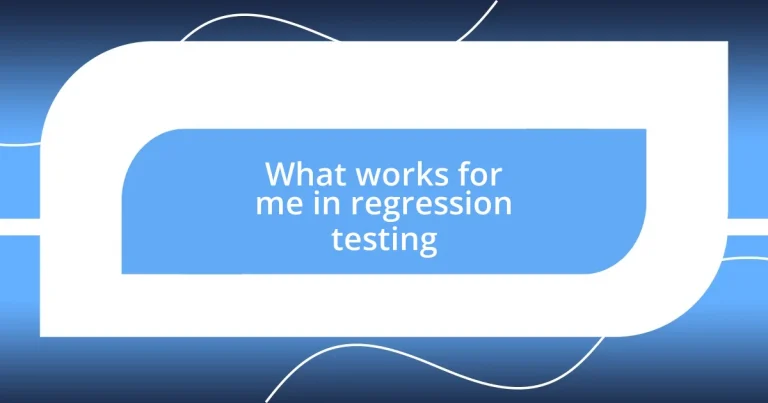Key takeaways:
- Regression testing provides peace of mind, ensuring existing functionalities remain intact and helps catch bugs early, saving time and resources.
- Employing strategies such as automating tests, prioritizing critical components, and integrating continuous testing enhances the effectiveness and efficiency of the testing process.
- Measuring success in regression testing requires looking beyond pass rates to consider user impact, fix resolution efficiency, and the rate of re-opened bugs, leading to continuous improvement.

Understanding Regression Testing Benefits
To me, one of the most significant benefits of regression testing is that it provides peace of mind. When I’ve pushed a new feature live, there’s always that nagging worry—did I break something else? Knowing that I’m running comprehensive regression tests allows me to verify that the existing functionality remains intact, and that’s a comforting feeling.
I remember a project where a minor update led to unexpected bugs in functionalities that hadn’t been touched in weeks. It was a frustrating experience, but it taught me the value of regression testing. The ability to catch these issues earlier in the development process can save time, money, and a lot of headaches in the long run. Isn’t it better to address problems before they impact users?
For me, regression testing also fosters a culture of quality within a team. When everyone knows that we’ll rigorously validate our work, it encourages us to write better code from the start. This collective commitment to quality not only enhances our product but also boosts team morale, as we share the accomplishment of delivering a reliable and robust solution. How can we not take pride in that?

Key Strategies for Effective Testing
A solid strategy I find effective in regression testing involves prioritizing test cases based on risk and impact. Not all features are created equal, and focusing on the most critical areas helps ensure that my testing efforts yield the best results. When I worked on a high-stakes project for a banking application, I learned the hard way that overlooking crucial components can lead to significant setbacks. By documenting and categorizing risky modules, I was able to allocate resources more wisely and reduce unnecessary testing time.
Here are some key strategies I recommend for effective regression testing:
- Automate Repetitive Tests: Automating tests saves time and reduces human error, allowing more focus on new features.
- Prioritize Test Cases: Focus on areas that have a history of issues or are critical to your application’s functionality.
- Use Version Control: Keeping track of changes helps identify what needs to be retested, streamlining the process.
- Incorporate Continuous Testing: Integrating testing into the CI/CD pipeline helps catch issues early, right when they occur.
- Regularly Review and Update Tests: As features evolve, so should your test cases. Regular reviews keep tests relevant and effective.
By implementing these strategies, I’ve seen significant improvements in my testing processes, and both the product and team morale benefited tremendously.

Tools That Enhance Regression Testing
When it comes to tools that enhance regression testing, I can’t recommend automation frameworks enough. In my experience, tools like Selenium and Cypress have revolutionized how I approach testing. They allow me to automate repetitive test cases, ensuring that I can focus on more complex, user-centric tasks. I remember feeling overwhelmed with manually running tests every time a feature changed, but once I started using these tools, that pressure lifted tremendously.
Another tool that I’ve found invaluable is TestRail for test case management. It keeps everything organized and allows my team to track test results effectively. The first time I used it, I was amazed at how quickly we could share insights and prioritize tests collaboratively. This streamlined communication felt like a breath of fresh air during development sprints, helping us stay agile and efficient. Isn’t it empowering to see all your testing efforts laid out clearly?
Lastly, I’ve integrated tools like JUnit or NUnit for running unit tests alongside my regression testing. These frameworks complement my overall testing strategy by catching issues at an earlier stage. This experience reminded me of a time when a minor bug slipped through the cracks—only to be identified later during regression testing. Had I used the unit tests more effectively from the start, that situation could have easily been avoided. I genuinely believe that leveraging these tools not only bolsters the reliability of my products but also fosters a deeper sense of accomplishment within the team.
| Tool | Description |
|---|---|
| Selenium | Open-source framework for automating web applications. |
| Cypress | End-to-end testing framework that makes testing easier and faster. |
| TestRail | Test case management tool that organizes testing efforts and results. |
| JUnit/NUnit | Unit testing frameworks for ensuring functionality during development. |

Automating Regression Testing Efficiently
Automating regression testing efficiently is all about finding the right balance between speed and accuracy. In my experience, I’ve found that creating a robust suite of automated tests drastically reduces the time spent on repetitive tasks. One time, I introduced automation on a project with a tight deadline; it felt like flipping a switch—tests that once took hours were completed in minutes. Isn’t it incredible how such tools can change the pace of our work?
Moreover, I’ve discovered that maintaining clear and updated documentation of automated test cases is crucial. During one project, I neglected to do this and ended up wrestling with an outdated script. It was a frustrating moment, as it wasted valuable time during crunch periods. By consistently reviewing and adjusting test cases, I’ve been able to avoid such pitfalls, ensuring that my automation efforts directly align with current requirements.
Finally, integrating feedback loops into the testing process makes a significant difference. I remember collaborating with developers to tweak automated tests based on their insights, which led to cleaner, more effective outcomes. How often do we realize that the best improvements come from teamwork? Embracing this collaborative spirit not only enhances test reliability but also builds a stronger relationship within the team.

Continuous Integration for Regression Testing
In my journey with continuous integration (CI) for regression testing, I’ve found that it greatly streamlines the testing process. The first time I set up a CI pipeline, I was amazed by how it automatically triggered my regression tests with every code commit. It felt like having a reliable assistant who always kept an eye on my code changes, ensuring nothing went awry unnoticed. Can you imagine the relief of knowing that your tests are consistently running and giving you instant feedback?
With CI, the collaboration between developers and testers becomes seamless. I recall a project where our team faced a significant deployment deadline, and communication gaps were common. When we adopted CI, the integration of regression testing meant that every member could see test results in real time. It really transformed how we approached releases. Rather than waiting for the end of the sprint to uncover issues, we were identifying and resolving them on the fly. Doesn’t that just make the development process feel more dynamic and responsive?
Also, the ability to analyze test results right after each integration helps in quickly addressing any bugs that slip through. I once encountered a scenario where a new feature caused unintended consequences in other areas—we caught it right away due to our CI setup. If we hadn’t had those regression tests integrated, we might have missed it until much later, leading to stressful overtime. In my experience, CI not only speeds up the testing process but also cultivates a proactive mindset, fostering a sense of ownership among all team members. Doesn’t it feel rewarding to be part of a system where everyone plays a crucial role in maintaining quality?

Measuring Success in Regression Testing
Measuring success in regression testing goes beyond just the number of tests passed. It’s about the context of those tests and their impact on the overall product stability. For instance, during a late-stage project, I noticed we had a 95% pass rate on our regression tests, but our customer feedback indicated serious issues. That stark contradiction made me realize that success can’t be measured solely by numbers; the real success lies in delivering a product that meets user expectations.
I’ve also found that keeping an eye on the time spent fixing issues revealed by regression tests is a valuable metric. Early in my career, I tracked every bug that slipped through and discovered that while our tests flagged them, our team took longer to resolve them than we anticipated. This led to discussions about improving our test coverage—it’s not just about catching bugs but ensuring that they are manageable when they arise. Have you ever considered how the efficiency of resolving these issues can inform your testing strategies?
Another key indicator of success I’ve adopted is monitoring the rate of re-opened bugs after a release. This practice became evident during a campaign where we released updates without adequate regression testing, resulting in multiple bugs reappearing. I felt the weight of those mistakes, as we had to scramble to restore confidence among users. This experience reinforced the idea that successful regression testing is measured not only by catching bugs before deployment but also by ensuring those fixes endure. I now prioritize tracking these metrics to refine our approach continuously. Isn’t it fascinating how the very process we put in place can evolve with every lesson learned?











